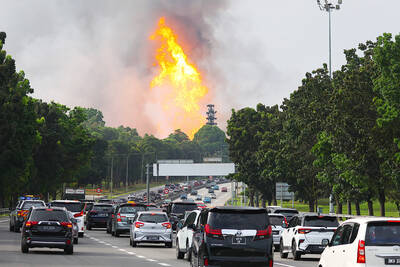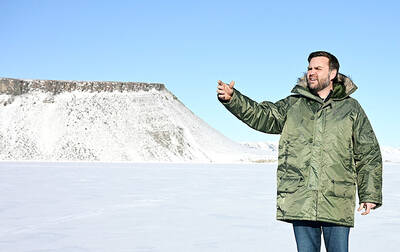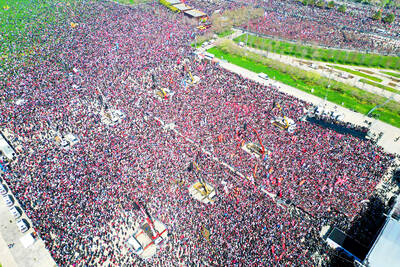Fourteen shot at a trading company. At least 90 kidnapped at other businesses. Bodies dumped nightly, bound, some tortured. A new brand of violence -- a deadly mix of organized crime and sectarian murder -- is tearing at Iraq.
Its origins are murky. But the savagery has turned this month into a pivotal one in the three-year war -- a month of gruesome news, mixed with some good. A sharp decline in US deaths appears to be the payoff for handing more duties to the Iraqi army, leaving US forces less exposed to attack.
At the same time, there has been the rise in the number of slayings of civilian Iraqis, the reasons for which are hard to find.
Not so many weeks ago, this was a conflict with straightforward, if brutal, terms. Sunni insurgents and al-Qaeda terrorists used car bombs, roadside bombs, suicide bomb belts and sniper rifles to target US troops, Iraqi soldiers, police and civilians -- mainly Shiites, the newly ascendent majority after years of former Iraqi president Saddam Hussein's oppression.
Those groups still operate and still kill. But their war has been dwarfed by the shadowy and incipient terror stalking the capital of Baghdad and nearby provinces.
Or perhaps -- as some Iraq officials believe -- the insurgents simply switched their targets, moving from US and Iraqi troops to targeting businesses and Iraqi civilians as a way to cause chaos or to fund their terror work.
Either way, the staggering shift makes it difficult to predict how the US military will or can react to the new climate of violence, and what it might mean for hopes to begin a troop pullout this summer.
Bombs still rattle the capital and elsewhere, but far less regularly. US helicopters still thunder through the sky, darting here and there and raising a racket that disturbs sleep and sends packs of wild dogs into a howling nighttime frenzy.
The tanks in the streets these days aren't American, by and large, but old Russian T-72s driven by Iraqi soldiers. Faces at military checkpoints are increasingly Iraqi.
As of Wednesday, 27 US military personnel had died this month -- the lowest monthly US death count since February 2004 and the second-lowest of the war, according to an Associated Press count.
Coincidental with the sharp drop in US deaths was the huge rise in the number of execution-style killings among Iraqis. Since the beginning of the month, at least 385 people -- an average of more than 13 a day -- have been found slain, the apparent victims of sectarian hatred and settling of old scores after a Shiite shrine was bombed on Feb. 22.
The count climbs to at least 486 when the last six days of February are added, according to figures compiled from daily AP reports based on police accounts.
Since the start of this month, gunmen -- mostly masked, many wearing police uniforms -- have stormed at least six Baghdad businesses. Execution-style killings and kidnappings of civilians happened before late last month, of course -- but not nearly in such big numbers.
In one rough accounting of the rise, for example, the AP reported 36 bodies found in Iraq in December, 150 in January and 195 last month. To date this month, the AP has reported 374 bodies found.
It is not always easy in war zones to separate criminal thugs from political thugs, and Iraq's insurgency has always been made up of several disparate groups.
However, organized crime may now account for a majority of the violence in the country, said Matthew Sherman, who has just finished a two-year stint advising the Interior Ministry.

A fire caused by a burst gas pipe yesterday spread to several homes and sent a fireball soaring into the sky outside Malaysia’s largest city, injuring more than 100 people. The towering inferno near a gas station in Putra Heights outside Kuala Lumpur was visible for kilometers and lasted for several hours. It happened during a public holiday as Muslims, who are the majority in Malaysia, celebrate the second day of Eid al-Fitr. National oil company Petronas said the fire started at one of its gas pipelines at 8:10am and the affected pipeline was later isolated. Disaster management officials said shutting the

US Vice President J.D. Vance on Friday accused Denmark of not having done enough to protect Greenland, when he visited the strategically placed and resource-rich Danish territory coveted by US President Donald Trump. Vance made his comment during a trip to the Pituffik Space Base in northwestern Greenland, a visit viewed by Copenhagen and Nuuk as a provocation. “Our message to Denmark is very simple: You have not done a good job by the people of Greenland,” Vance told a news conference. “You have under-invested in the people of Greenland, and you have under-invested in the security architecture of this

Japan unveiled a plan on Thursday to evacuate around 120,000 residents and tourists from its southern islets near Taiwan within six days in the event of an “emergency”. The plan was put together as “the security situation surrounding our nation grows severe” and with an “emergency” in mind, the government’s crisis management office said. Exactly what that emergency might be was left unspecified in the plan but it envisages the evacuation of around 120,000 people in five Japanese islets close to Taiwan. China claims Taiwan as part of its territory and has stepped up military pressure in recent years, including

UNREST: The authorities in Turkey arrested 13 Turkish journalists in five days, deported a BBC correspondent and on Thursday arrested a reporter from Sweden Waving flags and chanting slogans, many hundreds of thousands of anti-government demonstrators on Saturday rallied in Istanbul, Turkey, in defence of democracy after the arrest of Istanbul Mayor Ekrem Imamoglu which sparked Turkey’s worst street unrest in more than a decade. Under a cloudless blue sky, vast crowds gathered in Maltepe on the Asian side of Turkey’s biggest city on the eve of the Eid al-Fitr celebration which started yesterday, marking the end of Ramadan. Ozgur Ozel, chairman of the main opposition Republican People’s Party (CHP), which organized the rally, said there were 2.2 million people in the crowd, but